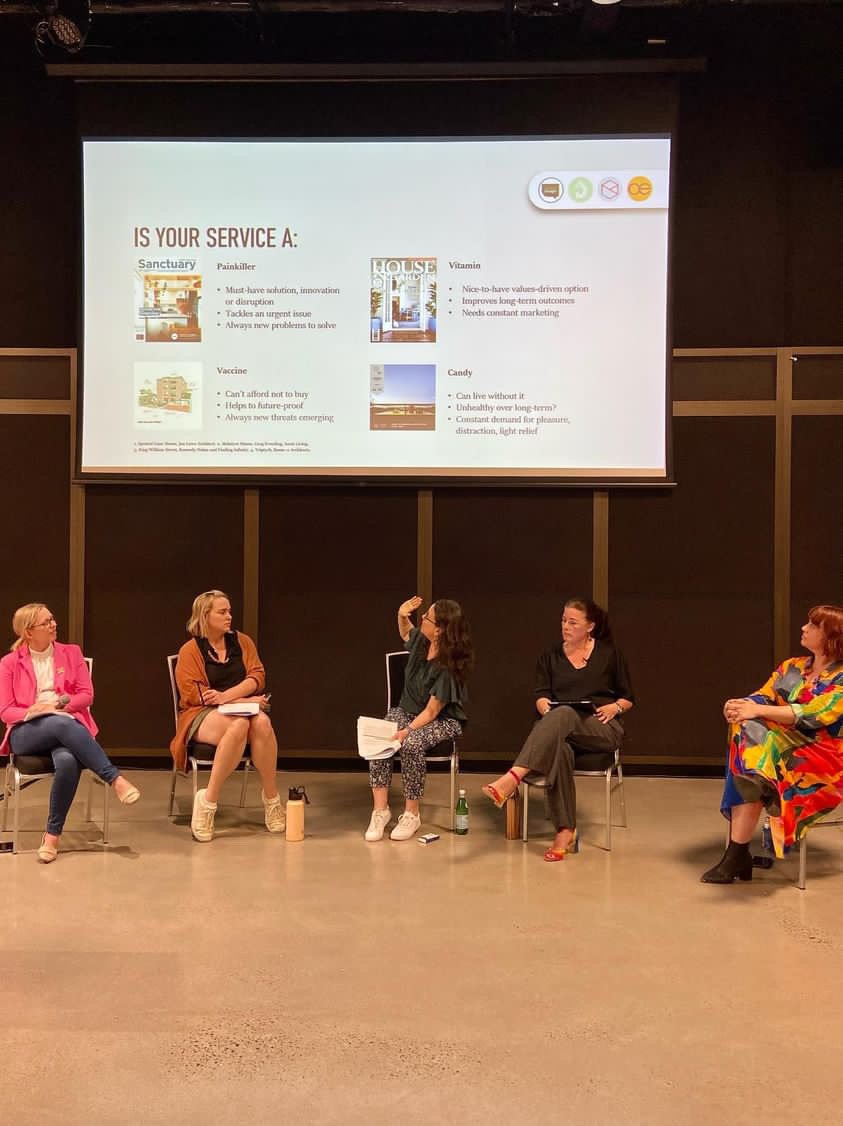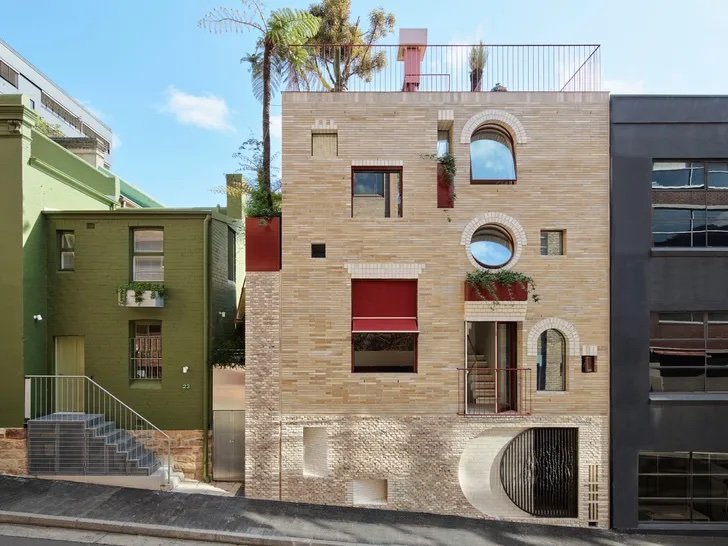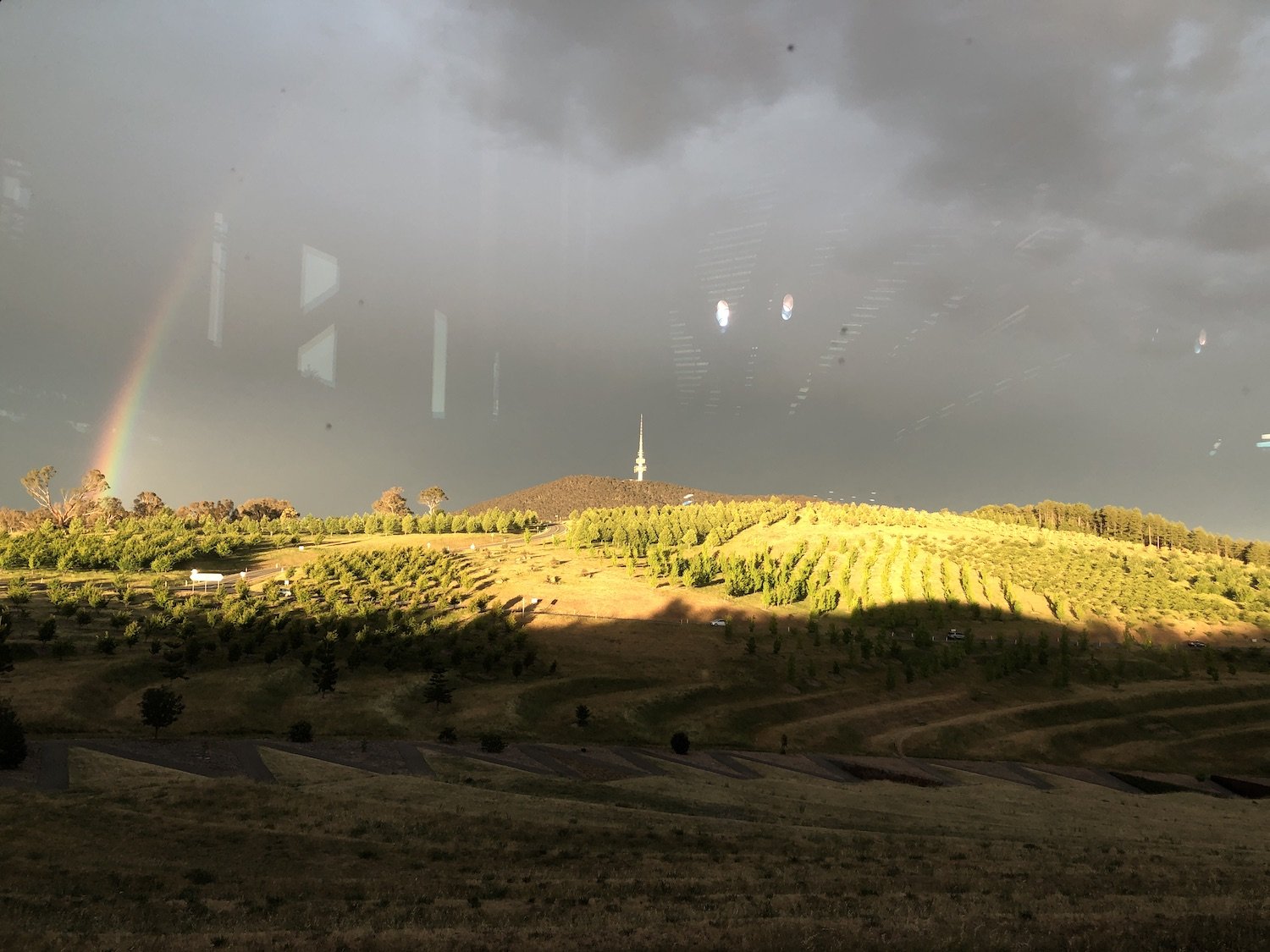12 things I learned at the National Architecture Conference and Awards in 2023
The process of collaborating and the conversations we had to put together our presentation - Practice? What are we practicing for? - with Sarah Lebner (second from left), Amelia Lee (second from right), and Rebecca Caldwell (right) - was one of the highlights of the conference for me.
1. Not everyone knows who you are, or what you do.
Most people who attended our presentations don’t know that I put together The Drill. Fewer still know that I have a CPD course available for architects to learn about business development and marketing. Some people don’t even know my name - someone called out and waved “Bye Saneia” to me at Canberra airport…
You have to tell people your name, what you do and what services you offer. On repeat. It may get boring to you, but they may be hearing it for the first time. Or it may take a while to make an impression, and that’s ok, we’re all busy and over-stimulated!
2. There is nothing like a real-life-in-person connection to bring people closer into your world.
It was wonderful to meet people that I’ve only ever emailed, talked to by phone, or had Zoom meetings before. And while those connections are great, it was so exciting to touch, hug, and enjoy each other’s company in real time. And seeing people who I haven’t seen for four years - since the #CollectiveAgency2019 conference - or even longer, was even more sweet.
Are you doing enough to prioritise enriching in-person connections?
3. People are amazed at my memory and recall of the tiniest, seemingly insignificant details.
One architect mentioned the fact that I can recall old news articles - when they were written, where they were published, and what they were about - going back years. And I blew the socks off an architect when - after not remembering her name, I was able to tell her exactly where we were standing - on the steps of the MSD, at the opening night of the 2015 Risk conference - when we first met. And then I recalled with both had a child the same age (her youngest, my oldest).
My memory is one of my superpowers and it still surprises me that not everyone else is the same. What’s your under-appreciated talent or skill that makes you so good at your job?
4. Telling your story builds trust and connection too.
I saw some people I’ve known for 15+ years and I told them all about what’s been happening at home, and the reasons I haven’t left WA for the past few years (beyond the period when we were locked in, during Covid). Sharing these stories builds empathy and understanding and helps to create really meaningful connections.
Don’t be afraid to share intimate details of your story with people you trust, and in places where it feels safe to do so.
5. The process of making plans with people - sending texts, DMs, emails, and group chats - provided unexpected moments of joy and delight.
Because I’ve been deliberately isolated and removed from social gatherings for a few years, while we’ve dealt with our family challenges, I hadn’t prioritised keeping up with people. Getting random pings and notifications on my phone brought a smile to my face every time; it’s lovely to be thought of and considered by someone else.
Are you investing enough time and effort into the relationships that bring you joy?
6. It’s always good to admit where you got something wrong, or you changed your mind, or you made a mistake and learned from it.
Speaking at the awards, Jeremy McLeod said that the success of the Nightingale Village proved that architects don’t need to rely on clients, or big budgets; that they can take the reins themselves. Then Clare Cousins qualified that by saying that none of them had much respect for developers before they started, but they do now. (And Jeremy McLeod has previously reflected elsewhere on how his perspective changed over the course of these projects, too)
Sharing the lessons you’ve learned, and the insights that have informed or reframed your perspective is a sign of maturity, reflection, and growth, and all of these qualities enhance trust and connection.
Jeremy McLeod (left) and Clare Cousins (right) accepted one of several awards given to Nightingale Village…
…by Hayball and Breathe and Architecture Architecture and Austin Maynard Architects and Clare Cousins Architects and Kennedy Nolan - at the National Awards in Canberra, 2023. Photography by Tom Roe.
7. It’s never too late to correct a mistake or right a wrong. Even 20 years later. As we saw with the very moving announcement that Maggie Edmond would also receive a Gold Medal alongside the one awarded to her late partner Peter Corrigan in 2003. I’m not sure there was a dry eye in the house as Shannon Battison stunned us all with the news. It was a rare magical moment!
Maggie Edmond was belatedly awarded another 2003 Gold Medal…
… correcting the record, after it was awarded to her partner Peter Corrigan alone 20 years ago. Photography by Tom Roe.
8. Sometimes in life you get a chance to work on a project that will have an impact, benefit, and ripple effect far beyond anything you could imagine. That was the case with the Family Violence memorial in Victoria, by Muir and Openwork, a confronting topic and project that arose from extensive and intense consultation with the people whose stories it honoured. I was in tears as Amy Muir described the importance of the work, for all the people involved and everyone else who may have suffered in silence before this small but moving memorial existed. Even more devastating was the fact that it had just been announced that five Australian women had died from family violence in the past 10 days.
As a person whose own life has been directly impacted by family violence, I can categorically say this: never underestimate the power of meaning-making through the manipulation of space and form to change people’s lives for the better, in ways you could never have predicted, and might never even become aware of. It bears repeating: architecture matters.
The Victorian Family Violence Memorial by Muir and Openwork won The Nicholas Murcutt Award at the 2023 National Awards in Canberra. Photography by Peter Bennetts.
Amy Muir accepting the award for The Victorian Family Violence Memorial by Muir and Openwork. Photography by Tom Roe.
9. When a project wins an award and it goes against type, the surprise and delight is all the sweeter. I went to the awards in an Uber with Adam Haddow, Emily Wombwell and Joel Sia from SJB. Adam’s a long-time friend and he said that while his own house was up for an award, they weren’t expecting to win any prizes. So it was especially exciting to see his own modest house - 19 Waterloo Street - take out the Robin Boyd Award. Last year, there was no award in that category (huh??) and previous winners have been mostly waterfront or rural homes, far removed from the houses most Australians live in. To me, this perpetuates the myth that architects and architecture are aloof and beyond the reach of the 97%, entrenching damaging stereotypes about the role of architects.
I understand that awards exist to showcase “the best” architecture, but I think we need to reconsider the qualities and characteristics we use to define “the best” in the context of addressing society’s major challenges: climate emergency, housing crisis, Designing for Country etc. As usual, there were some award winners that struck an incongruent note for me (overblown private school projects send the wrong message, I believe) but this one was pitch perfect.
19 Waterloo Street by SJB - Adam Haddow’s exemplary home - won the Robin Boyd Award. Photography by Anson Smart.
Adam Haddow accepting the award, with project architect Stewart Cowan. Photography by Tom Roe.
10. Not everyone will like what you say or do, or support your positions or actions, and that’s OK. I was told that someone had an objection to something I’d said in my first presentation, and they wanted to have a word with me about it. I sought out that person, who I knew, and gave them an opportunity to express their point of view. I agreed that what they’d described sounded challenging, and reasserted that my suggestion was still valid.
Not everything in life is either / or. A lot of conflicts and confrontations can be solved with a both / and approach. If you’re at odds with someone and experiencing a disagreement, is there a way to take the heat out of the situation and empathise with each other’s point of view, so that you can come to a resolution that works for both parties? Or just agree to disagree?
The view from the National Arboretum, at the Black and White Dinner hosted by Bondor Metecno. National Architecture Conference, Canberra, 2023.
11. If you can choose to be anything, be kind. If you notice that someone has made a mistake, rather than giving them a hard time about it, ask if they are ok, or could use a hand? Were they overwhelmed, in a rush, not sure how to complete a task, or otherwise challenged when they made the mistake? Resist the temptation to be sarcastic or passive aggressive; you don’t know what they may be going through behind the scenes.
An architect told me that she’s always experienced my emails, messages, and posts as supportive, empathetic and encouraging, and this is not an accident. I used to be snarky and funny and quick-witted, but those character traits hid (not very well!) my own insecurities, fears and anxieties, and my barbed remarks hurt people I cared about. If you can choose to respond with kindness or contempt, choose kindness every time.
12. There is very little that can’t be solved - at least in any given moment - by looking out at a stunning view of nature, and even better if there is a rainbow on the horizon. Nothing is permanent, everything changes and transforms, from moment to moment, so it’s useful to remember this:
The only moment we have is the present moment, so try and be present and enjoy it as much as possible.
If these 12 things resonate and you’d like to find out more about how we work with architects to communicate the value of good design to a wider audience - and grow architecture’s market share pie - read on:
You can purchase the Architecture Marketing 360: a CPD course for architects, here.
You can undertake the Review + Reset one-on-one consulting package with Rachael directly (find more details including pricing and the next available start date, here).
You can sign up to receive SLD’s newsletters and find out how The Drill provides a competitive edge here.
And if you have a friend or colleague who may also benefit from reading this article, please send them a link and encourage them to subscribe.










